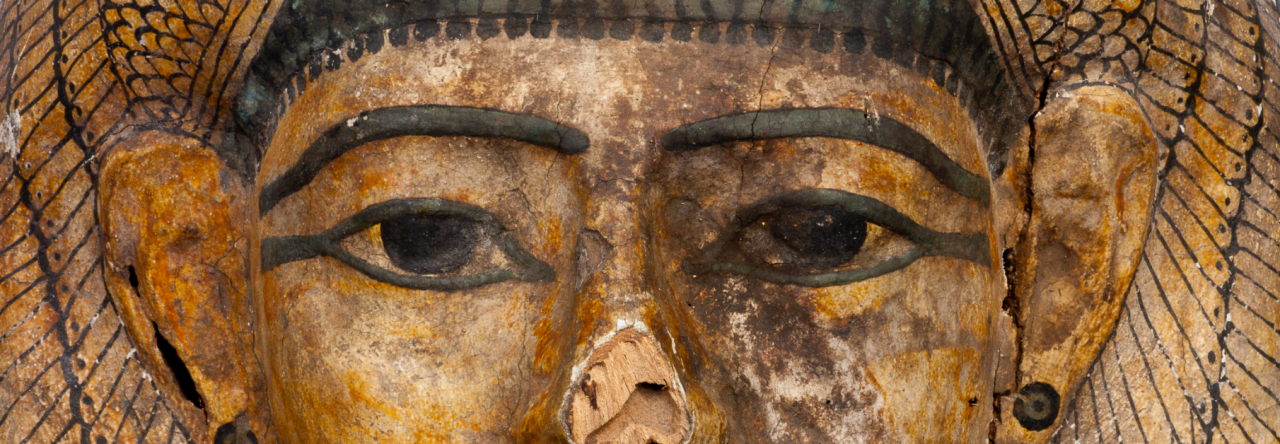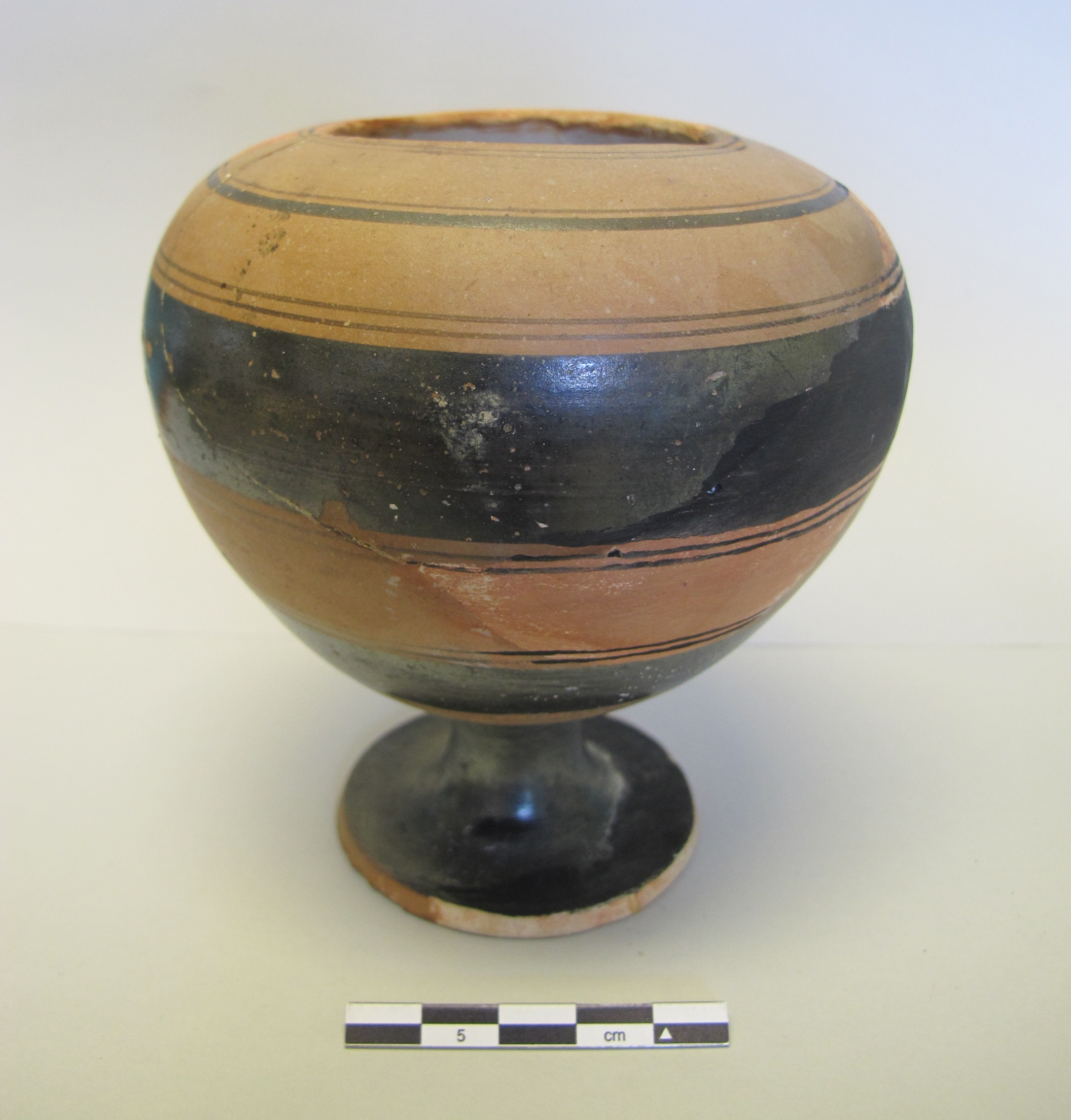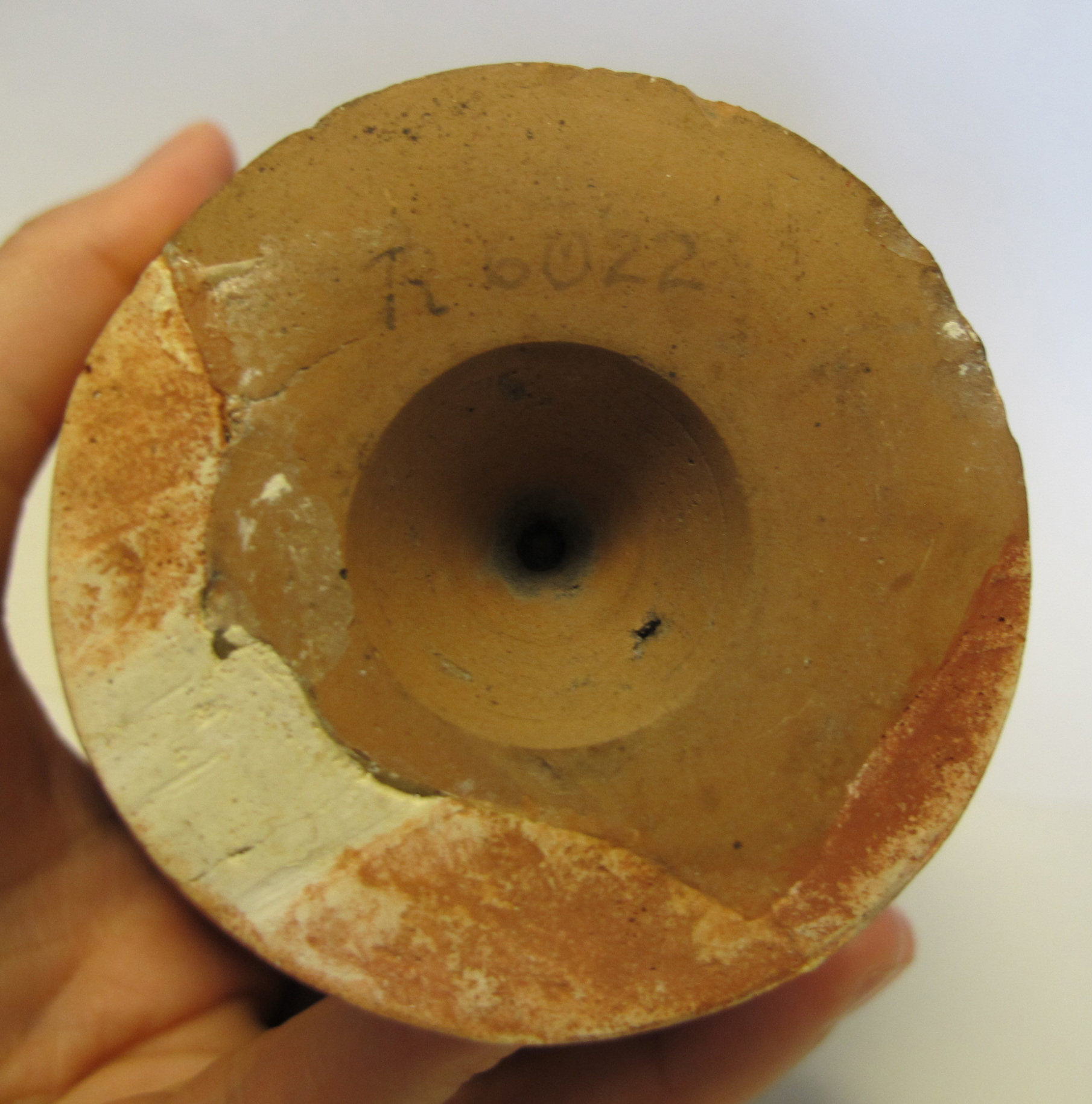AWG0000.01.12 (R6022)
Greek, Ionian
Archaic period (600-500 BCE)
Material: Ceramic
Technique: Metallic black slip on reserve
Style: Banded
Weight: 396g
Dimensions: 10.2 cm high, max. diameter 10 cm, base diameter 6.5 cm
Condition: fair; reconstructed with rough plaster filling, with attempted restoration of the original decoration; neck broken off
Provenance: Unknown
Source/donor: Unknown
Date of acquisition: Prior to 1939. The inventory number beginning with R suggests that it was part of the Richmond College Museum collection. Other R-numbered items were displayed in the Biology Museum in Maryland Hall beginning in 1932, and this vase appears in a photo of that museum published in 1939.
Research by: Lindsey Stevens, ’23
Detailed description of form/shape:
The piece features a small, round foot which extends into a very thin stem, and a large ovular body that gets wider as it progresses up towards a curved shoulder. (The neck and rim that are characteristic of the lydion shape are not preserved.)
Detailed description of decoration:
The original clay is fine light brown. The decoration consists of metallic gray-black, glossy horizontal bands: from top to bottom, two thin bands around the neck attachment; then a thin and thick band around the shoulder; then a pair of more thin horizontal bands, then a large band, followed by another pair of horizontal bands; then there is another sequence just like that, only with a thinner central band and without the first thin black line. The base and stem of the piece are both painted metallic black.
Comparanda:
For a lydion of similar base and body shape as well as fabric color and decoration (thin bands framing a thicker one), see the Ionian lydion British Museum 1863,0728.89, from Gela (Sicily). Another of similar shape and fabric is British Museum 1863,0728.87, also found in Gela (Sicily) and identified as Ionian in origin. A banded lydion in Munich (Cook and Dupont fig. 19.1b) has been identified as Milesian, Samian, or even Etruscan in origin (Wrigley 40; Cook and Dupont 132). All these examples, however, have only one thick band around the widest part of the body; another “East Greek” example in Geneva (MF 204; Beazley Archive Pottery Database vase no. 1010488) offers a closer parallel for our piece, with an additional thick band framed by thin bands encircling the lower part of the body.
For a lydion of standard Lydian form and decoration, see Metropolitan Museum of Art 26.199.64, from Sardis.
Discussion:
Lydions probably contained baccaris, an expensive perfumed ointment for which Sardis (the capital of ancient Lydia) was noted in antiquity. The distinctive shape of the lydion (round body with tall flaring neck and stemmed foot) would have advertised its contents and thus its owner’s wealth. In contrast to most other oil vessels, which had small handles and could be toted around on a strap (see the aryballos in this collection, for example), a lydion was made to be stationary, placed on display to make a statement to an audience. Lydions are often found alongside banqueting vessels in tombs, and perfumes were associated with banqueting, so a likely place for the lydion to be seen and used was among guests at a dinner party in a wealthy home.
This lydion looks different than most others, however, because it is missing the top element that would form the flaring neck and rim. Since lydia were made in three different parts (the foot, the body, and the neck and rim), the top part may have separated from the rest of the piece with such a clean break that it is difficult to tell it broke off.
The color of the clay fabric as well as the shape of the stemmed foot and the large size of this lydion are more comparable with Ionian imitations of Lydian vessels than with Lydian lydions (Cook and Dupont give 10 cm as “a usual height” for the Ionian type, 132). The distinctive Lydian vessel type was frequently imitated by the Ionian Greek neighbors of Lydia, perhaps because they were making these vessels to store perfumes imported from Lydia and wanted authentic-looking vessels to advertise the Lydian contents. Alternatively, Ionian potters could have made these imitation lydions to store locally produced perfumes in vessels that suggested Lydian origin. Ionian lydions are in fact part of a wider fascination with Lydian fashions seen in other aspects of archaic Greek art and poetry.
Bibliography:
Cook, Robert M. and Pierre Dupont. 1998. East Greek Pottery. London: Routledge.
Greenewalt, Crawford H. 1968. “Lydian Vases from Western Asia Minor.” California Studies in Classical Antiquity 1: 139–54. https://doi.org/10.2307/25010570.
Greenwalt, Crawford H. 2010. “Lydian Cosmetics” in The Lydians and their World, ed. by N.D. Cahill. https://sardisexpedition.org/en/essays/latw-greenewalt-lydian-cosmetics.
Wrigley, Susan. 2011. “The Lydion. Revealing Connectivity across the Mediterranean in the Sixth Century B.C.” Honors thesis, The University of Sydney, Sydney eScholarship Repository.



